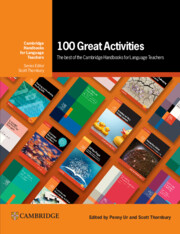2 - Listening
Published online by Cambridge University Press: 14 March 2024
Summary
The listening activities in this section invite the learners to respond to something they hear in a variety of ways: by physical action (‘Change chairs’, ‘Obeying instructions’), by suggesting immediate responses or questions (‘Predictive listening’, ‘True or false’) or by brief writing or drawing (‘Ground-plans’, ‘Altering and marking’). Significantly, none of them are based on listening ‘blind’ to the long stretches of audio recordings which often furnish the basis for listening practice in coursebooks and online materials; they rather involve listening and responding to input from the teacher as it is produced or, in one case, sorting out bits of speeches from video clips (‘Jumbled statements’). Essentially, all the activities in this section invite learners to listen, understand and respond to spoken texts through engaging with tasks based on interesting and enjoyable challenges.
Altering and marking
From Teaching Listening Comprehension by Penny Ur
Outline Students make alterations to pictures, maps, etc. in response to a spoken description
Author's comment Children particularly very much enjoy tampering with professionally drawn pictures: witness the moustaches, beards and hats drawn on to portraits, and the amount of filling-in, colouring and other kinds of artistic addition made by children to illustrations in their textbooks or storybooks (if allowed!). Note that as you improvise the instructions for this activity, make sure you include a lot of ‘redundancy’ – pauses or repetition or paraphrases or ‘fillers’ – in order to give students time to do the drawing or colouring.
Editors’ comment This is a very simple but fun listening task. It could also be turned into a two-way communicative activity, by putting learners into pairs or small groups to give similar instructions to one another.
Level Beginner to Elementary (A1–A2)
Preparation Give students a line drawing which has plenty of different people and things in it: see the example below.
Procedure
1 Tell the students to colour bits of the picture according to instructions: for example:
There are flowers on the table. They’re red, and they’re standing in a black vase. Got that? The vase is black all over, and the flowers are red … .
2 Then tell them to take a pencil and add things. For example:
Can you see a little baby in the picture? Ok, I want you to draw a hat on the baby's head. OK? A hat on the baby.
- Type
- Chapter
- Information
- Publisher: Cambridge University PressPrint publication year: 2024



